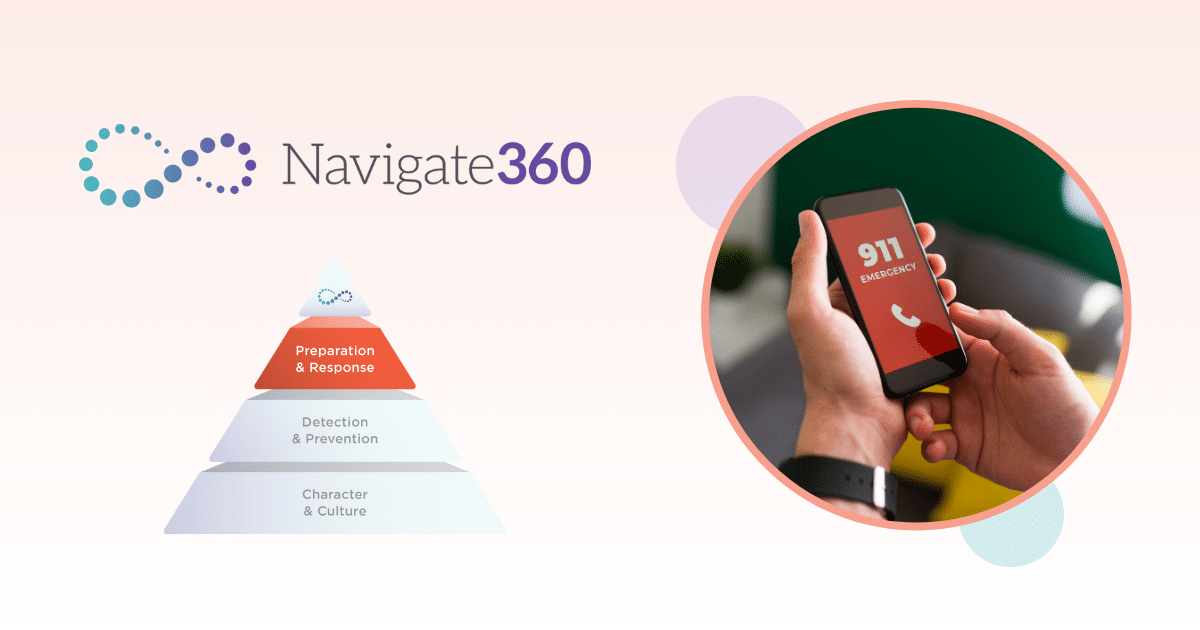One of the critical aspects of maintaining a school emergency operations plan (EOP) is conducting regular, purposeful school emergency drills. A well-managed and practiced drill program will not only boost your security team’s confidence and efficiency but will also ensure students and school personnel feel as prepared as possible for an emergency (and in most cases, drills are required by law). Just as a coach trains an athlete to excel at their sport, school safety teams must train students and faculty to respond quickly and appropriately should a real emergency occur.
Effective school emergency drills should cover a wide array of possible hazards, including:
- Medical emergencies
- Extreme weather and natural disasters
- Violence
- Self-harm
- Cybersecurity threats
Your school emergency operations plans should also include training new students and staff members who have not been involved in previous safety drills, along with a focus on a timely reunification process once the emergency is resolved. Setting the framework for easy communication before, during, and after a critical event through effective drill planning, training, and documentation will help to minimize stress and confusion during the reunification process of a drill or real-life critical event.
School Safety Drills That Comply with State Requirements
School safety drills must fully comply with all state requirements. Forty-five states mandate regular school safety or security drills—sometimes once a month or every semester—although specific requirements differ among states. Some states focus on lockdown and active shooter training, while others emphasize emergency evacuation and reunification drills.
Managing a team of security personnel while complying with state requirements in today’s rapidly changing education landscape can feel like a daunting task. To help school security teams operate at peak efficiency, Navigate360’s all-in-one Emergency Management Suite (EMS) allows your team to:
- View pre-loaded, state-specific drill and logging requirements
- Schedule, facilitate, manage, and log required school drills
- Facilitate required drills and find gaps in your team’s response
- Run reports on drills and share data if required
- Publish, organize, update, and share the latest safety protocols
Emergency Planning for Your District
The importance of having a well-constructed safety plan to manage your school’s security response cannot be overstated. Is your team prepared? Here are five steps to improving emergency preparedness for students and staff:
- Develop an emergency plan – Establish a cross-functional team made up of school personnel, first responders, and community leaders to develop a comprehensive school emergency operations plan. This plan should lay out instructions for possible emergency situations, including individual roles and responsibilities during these events.
- Develop a crisis response team – In collaboration with first responders, a crisis response team can provide the support and intervention students need after a critical event. Often made up of mental health experts, this team can provide various strategies to help students dealing with trauma.
- Develop a communication plan – Communication amongst school personnel, first responders, students, and parents/guardians is key before, during, and after emergencies. It can also be a lot to manage. EMS is a helpful tool in planning your communications response, as it provides an easily accessible, single source of truth to streamline communication during a crisis. Through virtual binders, cloud-based call lists, and other practical features, you’ll be able to easily communicate with staff, first responders, students, and families during a crisis, in addition to communicating in-app during an emergency through the Respond feature.
- Provide regular practice – Did you know less than 40% of teens are confident that their classmates know what to do in an emergency? Regular school safety drills and proactive training can increase preparedness and confidence in students, faculty, and security personnel alike.
- Partner with a safety expert – Developing and managing comprehensive school emergency operations plans to include emergency drills can sometimes feel overwhelming. Schools can partner with an industry safety expert to guide them through the process and recommend best practices for keeping their schools safe, secure, and compliant.
School Emergency Drills & Exercises
There are multiple considerations to keep in mind when planning school emergency drills and crisis exercises. For instance, drills must encompass emergencies that span from severe weather events to active shooters and medical crises and must account for the critical aspect of reunification following each of these emergencies. Navigate360 provides resources to ensure a swift and organized reunification process, including effortless syncing with student information systems (SIS).
Let’s explore some proven exercises that you can incorporate into your school’s emergency preparedness plans.
Simple Exercises
The prospect of facing an active shooter event or other crises is undoubtedly stressful for students, but your safety exercises don’t have to be. It’s best to start with simple, straightforward exercises, such as discussion-based methods that allow students to become familiar with the basics of school emergency response procedures, ask questions, and voice any concerns they may have. These simple discussions can go a long way toward reducing anxiety and boosting confidence and preparedness among staff and students.
Risk-Based Exercises
What are the biggest safety threats in your school district? The exercises you choose should be based on the answer to this question. Regularly perform risk assessments to promptly identify and prioritize safety risks and mitigate them by practicing the most appropriate and meaningful drills.
Discussion-Based Exercises (“Tabletop” Drills)
One popular method of discussion-based training is a “tabletop” exercise. These scenario-based exercises walk students through emergency situations that can arise in a school setting, such as:
- A student going into anaphylactic shock
- A teacher collapsing during class
- A student going through a mental health crisis
- A loss of power during extremely hot or cold weather
During the discussed-based exercise, students, faculty, and other members of the school’s emergency response team will discuss each group’s individual responsibilities if the crisis were to take place. Outlining emergency protocols for specific scenarios will enhance preparedness and allow for a more confident and effective response should they occur.
Operations-Based Exercises
Interactive, operations-based exercises can sometimes be complex and costly to perform, but they are arguably the most impactful and can quickly expose holes in your school’s emergency response plans. These drills involve running live simulations of emergency events, including real-world “surprises” such as a blocked staircase or loss of power.
Types of operations-based exercises include:
- Emergency drills that focus on a single crisis, lasting 30 minutes to two hours
- Functional exercises that are played out in real-time, lasting roughly three to eight hours
- Full-scale drills that are carried out in real-time may last several hours or a few days and involve the participation of emergency personnel or local authorities
Before running an operations-based exercise, be sure to thoroughly communicate plans with all students, parents, stakeholders, and necessary personnel in advance. Drills and functional exercises should never be a surprise to participants.
Important Takeaways for Managing Emergency Drills Within Your District
To review, a well-executed school emergency drill should:
- Thoroughly test current emergency response protocols
- Uncover weaknesses and holes in emergency procedures
- Improve emergency response and coordination among security personnel
- Clarify specific roles and responsibilities among staff, students, and first responders
- Boost confidence in an individual’s ability to play their part
- Be regularly reviewed and updated as necessary
Additionally, state and federal compliance is of the utmost priority. Through Navigate360’s EMS, you’ll be able to quickly access pre-loaded and annually updated compliance requirements that are specific to your state. Furthermore, the Safety Plan Wizard in the EMS will allow you to easily create and manage critical emergency operations documents.
To learn more about the many advantages of Navigate 360’s Emergency Management Suite and how it can benefit your district, contact us today.
Discover the Power of an Emergency Management System for School Drills
Navigate360 recognizes the need for a comprehensive solution that not only aids in executing emergency plans but also manages and tracks drills, accounting for every student in times of crisis, including during the crucial process of family reunification.
Our cutting-edge Emergency Management Suite equips schools with a robust, user-friendly, cloud-based solution, empowering them to actively ready themselves for emergencies, respond promptly, and efficiently recover in real-time. By utilizing our suite, you gain campus-wide oversight, foster accountability, and establish seamless communication channels.
Drills will continue to be a key practice in refining emergency preparedness within schools. Solutions like Navigate360’s Emergency Management Suite bolster a culture of safety, paving the way for a more secure tomorrow. Download our Emergency Management Suite brochure to see how you can keep your staff and students safe through simplified preparedness, response, and compliance.




